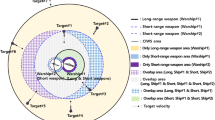Abstract
An appropriate selection of agents to participate in a confrontation such as a game or combat depends on the types of the opposing team. This paper investigates the problem of determining a combination of agents to fight in a combat between two forces. When the types of enemy agents committed to the combat are not known, game theory provides the best response to the opponent. The entry game is solved by using mixed integer linear programming (MILP) to consider the constraints on resources in a game theoretic approach. Simulations for the examples involving three different sets of military forces are performed using an optimization tool, which demonstrates that the optimal entry is properly selected corresponding to the opposing force.
Similar content being viewed by others
References
A. K. Dixit, and B. J. Nalebuff, Think Strategically, Norton, 1993.
P. R. Thie, and G. E. Keough, An Introduction to Linear Programming and Game Theory, 2nd ed. Wiley, New York, 2008. [click]
O. G. Haywood, “Military decision and game theory,” Journal of the Operations Research Society of America, vol. 2, pp. 365–385, 1954. [click]
F. Austin, et al., “Game theory for automated maneuvering during air-to-air combat,” Journal of Guidance, vol. 13, pp. 1143–1149, 1990. [click]
J. B. Cruz, et al., “Game-theoretic modeling and control of a military air operation,” IEEE Transactions on Aerospace and Electronic Systems, vol. 37, no. 4, pp. 1393–1404, 2001. [click]
J. B. Cruz, et al., “Moving horizon nash strategies for a military air operation,” IEEE Transactions on Aerospace and Electronic Systems, vol. 38, no. 3, pp. 989–997, 2002. [click]
D. Ghose, J. L. Speyer, and J. S. Shamma, “A game theoretical multiple resource interaction approach to resource allocation in an air campaign,” Annals of Operations Research, vol. 109, pp. 15–40, 2002. [click]
P. S. Sheeba, and D. Ghose, “A resource based game theoretical model for military conflicts,” DRDO-IISc Programme on Advanced Research in Mathematical Engineering, 2005.
A. Bemporad and M. Moran, “Control of systems integrating logic, dynamics, and constraints,” Automatica, vol. 35, pp. 407–427 1999. [click]
J. C. Smith, and Z. C. Taskin, A tutorial guide to mixedinteger programming models and solution techniques, University of Florida, 2007.
B. J. Griggs, G. S. Parnell, and L. J. Lehmkuhl, “An air mission planning algorithm using decision analysis and mixed integer programming,” Operations Research, vol. 45, pp. 662–676, 1997. [click]
G. Brown, et al., “A two-sided optimization for theater ballistic missile defense,” Operations Research, vol. 53, pp. 745–763, 2005. [click]
C. C. Murray and M. H. Karwan, “An extensible modeling framework for dynamic reassignment and rerouting in cooperative airborne operations,” Naval Research Logistics, vol. 57, 6 pp. 34–652, 2010. [click]
J. A. Sundali, et al., “Coordination in market entry games with symmetric players,” Organizational Behavior and Human Decision Processes, vol. 64, no. 2, pp. 203–218, 1995. [click]
A. Rapoprt, et al., “Equilibrium play in large group market entry games,” Management Science, vol. 44, no. 1, pp. 119–141, 1998. [click]
J. Duffy and E. Hopkins, “Learning, information, and sorting in merket entry games: theory and evidence,” Games and economic behavior, vol. 51, no. 1, pp. 31–62, 2005. [click]
P. Lichocki, et al., “Evolving Team Compositions by Agent Swapping,” IEEE Transactions on Evolutionary Computation, vol. 17, no. 2, pp. 282–298, 2013. [click]
M. Waibel, L. Keller, and F. Floreano, “Genetic Team Composition and Level of Selection in the Evolution of Cooperation,” IEEE Transactions on Evolutionary Computation, vol. 13, no. 3, pp. 648–660, 2009. [click]
T. Basarand G. J. Olsder, Dynamic noncooperative game theory, Academic, London, 1982. [click]
P. K. Dutta, Strategies and games: theory and practice, The MIT Press, 1999.
J. S. Shamma, Cooperative control of distributed multiagent systems, John Wiley & Sons, 2007. [click]
L. A. Wolsey, Integer programming, Wiley, New York, 1998.
I. Ravid, “Military decision, game theory and intelligence: An anecdote,” Operations Research, vol. 38, no. 2, pp. 260–264, 1990 [click].
Author information
Authors and Affiliations
Corresponding author
Additional information
Recommended by Associate Editor Young Soo Suh under the direction of Editor Fuchun Sun. This work was supported in part by a grant for High-speed Flight Vehicle Research Center (HV-63) funded by Defense Acquisition Program Administration, National Research Foundation of Korea Grant funded by the Korean Ministry of Science, ICT and Future Planning (2015-008849), and Korea Ministry of Land, Transport and Maritime Affairs as Haneul Project.
Seungmin Baek received the B.S. degree in Bio-systems Engineering from Seoul National University in 2009 and the M.S. degree in Mechanical and Aerospace Engineering from Seoul National University in 2011. His research interests include control and coordination of multi-agent systems.
Sungwon Moon received the B.S. degree in Mechanical and Aerospace Engineering from Seoul National University in 2007 and is pursuing his Ph.D. degree in Mechanical and Aerospace Engineering from Seoul National University. His research interests include control and coordination of multiagent systems.
H. Jin Kim received the B.S. degree from Korea Advanced Institute of Science and Technology in 1995 and the M.S. and Ph.D. degrees from University of California, Berkeley in 2001, all in Mechanical Engineering. She is currently a Professor in Mechanical and Aerospace Engineering at Seoul National University.
Rights and permissions
About this article
Cite this article
Baek, S., Moon, S. & Kim, H.J. Entry optimization using mixed integer linear programming. Int. J. Control Autom. Syst. 14, 282–290 (2016). https://doi.org/10.1007/s12555-014-0270-6
Received:
Revised:
Accepted:
Published:
Issue Date:
DOI: https://doi.org/10.1007/s12555-014-0270-6




